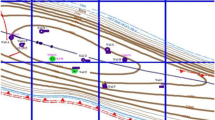Abstract
In this research work, the effects of hydrate inhibitors on the rheological behavior of drilling fluids were thoroughly analyzed for gas hydrate-bearing formations under the ocean floor conditions. Initially, base drilling fluids were prepared using carboxy methyl cellulose, polyanionic cellulose, xanthan gum, calcium carbonate and potassium chloride. Further, three kinetic inhibitors and two thermodynamic inhibitors were added in these base drilling fluids to maintain the rheological characteristics for optimum drilling performance at low-temperature conditions. Response surface methodology in conjunction with the central composite design was utilized to evaluate and optimize the drilling fluid combinations to get the desired response in terms of apparent viscosity at different temperatures. The software analyzed the data and optimized drilling fluid combinations for gas hydrate formation in offshore conditions. The optimized drilling fluids have shown desired results which may be used for the drilling of gas hydrate-bearing formations.
Similar content being viewed by others
Abbreviations
- RSM:
-
Response surface methodology
- CCD:
-
Central composite design
- DF-1:
-
Drilling fluid with thermodynamic inhibitor
- DF-2:
-
Drilling fluid with kinetic inhibitor
- wt%:
-
Weight percentage
- PVP (K-15):
-
Polyvinylpyrrolidone (K-15)
- PVCap:
-
N-Vinyl-\(\upvarepsilon \)-caprolactam
- VC 713:
-
2-(Dimethylamino) ethyl methacrylate
- LV:
-
Low viscosity
- C[1]:
-
VC 713
- C[2]:
-
PVP (K-15)
References
Makogon, Y.F.; Holditch, S.A.; Makogon, T.Y.: Natural gas-hydrates—a potential energy source for the 21st century. J. Petrol. Sci. Eng. 56, 14–31 (2007)
Kelland, M.A.: Production Chemicals for the Oil and Gas Industry, vol. XVII. CRC Press, Boca Raton (2009)
Sloan, E.D.; Koh, C.A.: Clathrate Hydrates of Natural Gases, vol. XXV. CRC Press, Boca Raton, FL (2007)
Saw, V.K.; Gudala, M.; Udayabhanu, G.; Mandal, A.; Laik, S.: Kinetics of methane hydrate formation and its dissociation in presence of non-ionic surfactant Tergitol. J. Unconv. Oil Gas Resour. 6, 54–59 (2014)
Dalmazzone, B.; Herzhaft, B.; Rousseau, L.; Le, P.P.: Prediction of Gas Hydrate Formation with DSC Technique. SPE ATCE, Denver, CO (2003)
Saw, V.K.; Gudala, M.; Udayabhanu, G.; Mandal, A.; Laik, S.: Methane hydrate formation and dissociation in synthetic seawater. J. Nat. Gas Chem. 21, 625–632 (2012)
Kvenvolden, K.A.: Gas hydrates—geological perspective and global change. Rev. Geophys. 31, 173 (1993)
Ruppel, C.: Thermal state of the gas hydrate reservoir. In: Max, M.D. (ed.) Natural Gas Hydrate in Oceanic and Permafrost Environments, pp. 29–42. Kluwer Academic Publications, Dordrecht (2000)
Birchwood, R.A., Noeth, S., Tjengdrawira, M.A., Kisra, S.M., Elisabeth, F.L., Sayers, C.M., et al.: Modeling the mechanical and phase change stability of wellbores drilled in gas hydrates. Technical Report for Joint Industry Participation Program (JIPP) Gas Hydrates Project, Phase II: Anaheim, CA, USA (2007)
Yonghong, S.; Xiaoshu, L.; Wei, G.: A review on simulation models for exploration and exploitation of natural gas hydrate. Arab. J Geosci. 7, 2199–2214 (2014)
Liu, T.; Jiang, G.; Ning, F.; Zhang, L.; Tu, Y.: Inhibition of polyethylene glycol drilling fluid with kinetic inhibitor for marine gas hydrates formation. Geol. Sci. Tech. Inf. 29, 116–120 (2010)
Kelland, M.A.: History of the development of low dosage hydrate inhibitors. Energy Fuels 20, 825–847 (2006)
Fan, S.S.; Zhang, Y.Z.; Tian, G.L.; Liang, D.Q.; Li, D.L.: Natural gas hydrate dissociation by presence of ethylene glycol. Energy Fuels 20, 324–326 (2006)
Dick, M.A., Heinz, T.J., Svoboda, C.F., Aston, M.: Optimizing the selection of bridging particles for reservoir drilling fluids. In: SPE International Symposium, 23–24 February 2000, Lafayette, Louisiana (2000)
Shuli, D., Jienina, Y.: Optimization of drilling fluid rheology model using least square fitting method. Petroleum Drilling Techniques. http://en.cnki.com.cn (2000)
Menezes, R.R.; Brasileiro, M.I.; Gonçalves, W.P.; Santana, L.N.L.; Neves, G.A.; Ferreira, H.S.; Ferreira, H.C.: Statistical design for recycling kaolin processing waste in the manufacturing of mullite-based ceramics. Mater. Res. 12(2), 201–209 (2009)
Montgomery, D.C.: Design and Analysis of Experiments, 5th edn. Wiley Interscience, New York (2001)
Menezes, R.R.; Marques, L.N.; Campos, L.A.; Ferreira, H.S.; Santana, L.N.L.; Neves, G.A.: Use of statistical design to study the influence of CMC on the rheological properties of bentonite dispersions for water-based drilling fluids. Appl. Clay Sci. 49, 13–20 (2010)
Box, G.E.P.; Draper, N.R.: Empirical Model Building and Response Surfaces. Wiley, New York, NY (1987)
Venter, G.; Haftka, R.T.; Starnes Jr., J.H.: Construction of response surfaces for design optimization applications. In: 6th AIAA/USAF/NASA/ISSMO Symposium on Multidisciplinary Analysis and Optimization. Bellevue, WA, AIAA Inc, vol. 1, pp. 548–564 (1996)
Montgomery, D.C.: Design and Analysis of Experiments, 4th edn. Wiley, New York (1997)
Eschenauer, H.A.; Lautenschlager, U.; Mistree, F.: Multiobjective flywheel design: a DOE-based concept exploration task. In: Proceedings ASME Design. Engineering technical conferences, Sacramento, California, pp. 1–12 (1997)
Wu, S.; Zhang, G.; Huang, Y.; Liang, J.; Wong, H.K.: Gas hydrate occurrence on the continental slope of the northern South China Sea. Mar. Pet. Geol. 22, 403–412 (2005)
Lin, G.; Hu, T.; Peng, J.; et al.: Optimization of experiments for microwave drying of hydrometallurgy mud using response surface methodology. Arab. J. Sci. Eng. 41(2), 569–576 (2016)
Aïda, A.; Mabrouk, E.; Nejib, K.; Mourad, B.: Application of Tunisian limestone material for chlorobenzene adsorption: characterization and experimental design. Arab. J. Geosci. 8, 11183–11192 (2015)
Chen, X.; Du, W.; Liu, D.: Response surface optimization from biocatalytic biodiesel production with acid oil. Biochem. Eng. J. 40, 423–429 (2008)
Arun, P.; Pudi, S.M.; Biswas, P.: Acetylation of glycerol over sulphated alumina: reaction parameter study and optimization using response surface methodology (RSM). Energy Fuels 30(1), 584–593 (2015). https://doi.org/10.1021/acs.energyfuels.5b01901
Noordin, M.Y.; Venkatesh, V.C.; Sharif, S.; Elting, S.; Abdullah, A.: Application of response surface methodology in describing the performance of coated carbide tools when turning AISI 1045 steel. J. Mater. Process. Technol. 145, 46–58 (2004)
Matlob, A.S.; Kamarudin, R.A.; Jubri, Z.; Ramli, Z.: Response surface methodology for optimizing zeolite Na-A synthesis. Arab. J. Sci. Eng. 38(7), 1713–1720 (2013)
Author information
Authors and Affiliations
Corresponding author
Rights and permissions
About this article
Cite this article
Saikia, T., Mahto, V. Experimental Investigations and Optimizations of Rheological Behavior of Drilling Fluids Using RSM and CCD for Gas Hydrate-Bearing Formation. Arab J Sci Eng 43, 6541–6554 (2018). https://doi.org/10.1007/s13369-018-3292-1
Received:
Accepted:
Published:
Issue Date:
DOI: https://doi.org/10.1007/s13369-018-3292-1




